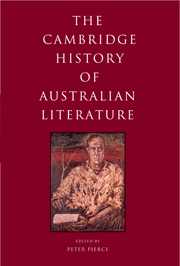Book contents
- Frontmatter
- Introduction
- FROM EUROPEAN IMAGININGS OF AUSTRALIA TO THE END OF THE COLONIAL PERIOD
- FROM THE LATE NINETEENTH CENTURY TO 1950
- 7 Australia’s Australia
- 8 The short story, 1890s to 1950
- 9 Australian drama, 1850–1950
- 10 ‘New words come tripping slowly’: Poetry, popular culture and modernity, 1890–1950
- 11 Australian fiction and the world republic of letters, 1890–1950
- 12 Australia’s England, 1880–1950
- TRAVERSES
- FROM 1950 TO NEARLY NOW
- Select bibliography
- Index
- References
9 - Australian drama, 1850–1950
from FROM THE LATE NINETEENTH CENTURY TO 1950
Published online by Cambridge University Press: 28 May 2011
- Frontmatter
- Introduction
- FROM EUROPEAN IMAGININGS OF AUSTRALIA TO THE END OF THE COLONIAL PERIOD
- FROM THE LATE NINETEENTH CENTURY TO 1950
- 7 Australia’s Australia
- 8 The short story, 1890s to 1950
- 9 Australian drama, 1850–1950
- 10 ‘New words come tripping slowly’: Poetry, popular culture and modernity, 1890–1950
- 11 Australian fiction and the world republic of letters, 1890–1950
- 12 Australia’s England, 1880–1950
- TRAVERSES
- FROM 1950 TO NEARLY NOW
- Select bibliography
- Index
- References
Summary
From one perspective – the one that has until recently dominated attempts to map Australian drama and theatre in the second half of the 19th and the first half of the 20th centuries – the terrain looks decidedly barren. Writing for the theatre added to the challenges faced routinely by the post-colonial novelist or poet (the discovery of a distinctive voice and a willing publisher) the problem of actually getting the script to the stage, and of finding the many willing and able hands that were necessary to take it there. The successes were few, and modest at that. Louis Esson’s Pioneer Players staged five full-length plays in Melbourne from 1922 to 1926 and 12 one-acters, only two of the seasons lasting for more than ‘one consecutive performance’, as Esson wryly put it. Yet the playwright somehow gained in this context a heroic importance that seems incongruous in the light of the Pioneers’ record and standard of production.
It suited the myth to see the writer as an intrepid explorer in a barren land, and to adapt the powerful Australian iconography of a continent empty and unknown at its heart. Esson certainly liked to see himself as that kind of pioneer, and the fact that his journeyings mostly ended in disaster simply added to the strength of the metaphor and the status of the playwright. The myth rested on the assumption that there were no footprints in that particular desert. It was a seductive idea, seemingly confirmed during the first six decades of the 20th century by the almost complete absence of plays by Australian writers from the commercial stage. The related perception that Australian drama through the century is a series of births, deaths and renaissances owes something to shifts in the national culture and economy, but perhaps even more to the systematic denial and forgetting of what had gone before.
- Type
- Chapter
- Information
- The Cambridge History of Australian Literature , pp. 180 - 198Publisher: Cambridge University PressPrint publication year: 2009

